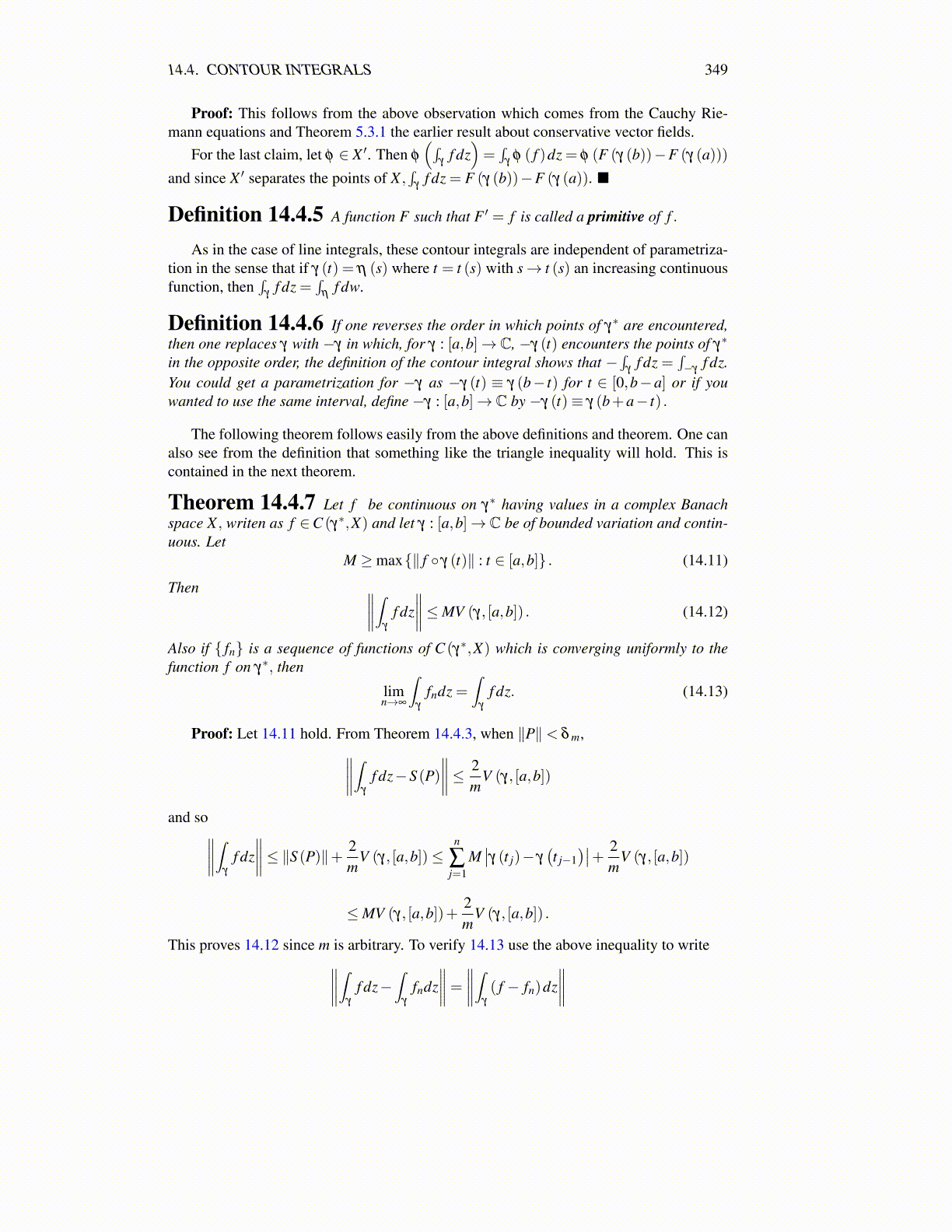
14.4. CONTOUR INTEGRALS 349
Proof: This follows from the above observation which comes from the Cauchy Rie-mann equations and Theorem 5.3.1 the earlier result about conservative vector fields.
For the last claim, let φ ∈ X ′. Then φ
(∫γ
f dz)=∫
γφ ( f )dz = φ (F (γ (b))−F (γ (a)))
and since X ′ separates the points of X ,∫
γf dz = F (γ (b))−F (γ (a)). ■
Definition 14.4.5 A function F such that F ′ = f is called a primitive of f .
As in the case of line integrals, these contour integrals are independent of parametriza-tion in the sense that if γ (t) = η (s) where t = t (s) with s→ t (s) an increasing continuousfunction, then
∫γ
f dz =∫
ηf dw.
Definition 14.4.6 If one reverses the order in which points of γ∗ are encountered,then one replaces γ with −γ in which, for γ : [a,b]→ C, −γ (t) encounters the points of γ∗
in the opposite order, the definition of the contour integral shows that −∫
γf dz =
∫−γ
f dz.You could get a parametrization for −γ as −γ (t) ≡ γ (b− t) for t ∈ [0,b−a] or if youwanted to use the same interval, define −γ : [a,b]→ C by −γ (t)≡ γ (b+a− t) .
The following theorem follows easily from the above definitions and theorem. One canalso see from the definition that something like the triangle inequality will hold. This iscontained in the next theorem.
Theorem 14.4.7 Let f be continuous on γ∗ having values in a complex Banachspace X , writen as f ∈C (γ∗,X) and let γ : [a,b]→ C be of bounded variation and contin-uous. Let
M ≥max{∥ f ◦ γ (t)∥ : t ∈ [a,b]} . (14.11)
Then ∥∥∥∥∫γ
f dz∥∥∥∥≤MV (γ, [a,b]) . (14.12)
Also if { fn} is a sequence of functions of C (γ∗,X) which is converging uniformly to thefunction f on γ∗, then
limn→∞
∫γ
fndz =∫
γ
f dz. (14.13)
Proof: Let 14.11 hold. From Theorem 14.4.3, when ∥P∥< δ m,∥∥∥∥∫γ
f dz−S (P)∥∥∥∥≤ 2
mV (γ, [a,b])
and so∥∥∥∥∫γ
f dz∥∥∥∥≤ ∥S (P)∥+ 2
mV (γ, [a,b])≤
n
∑j=1
M∣∣γ (t j)− γ
(t j−1
)∣∣+ 2m
V (γ, [a,b])
≤MV (γ, [a,b])+2m
V (γ, [a,b]) .
This proves 14.12 since m is arbitrary. To verify 14.13 use the above inequality to write∥∥∥∥∫γ
f dz−∫
γ
fndz∥∥∥∥= ∥∥∥∥∫
γ
( f − fn)dz∥∥∥∥